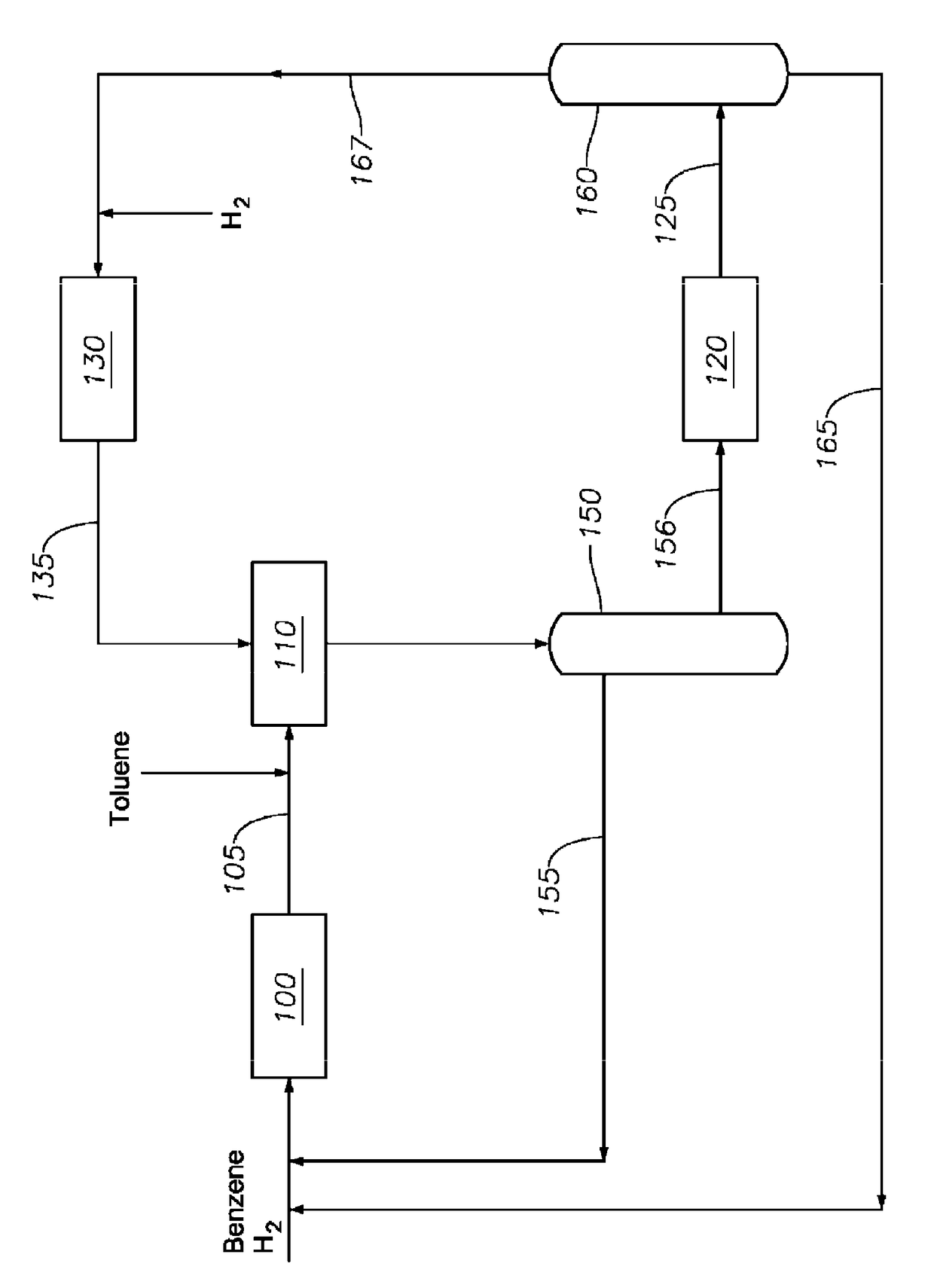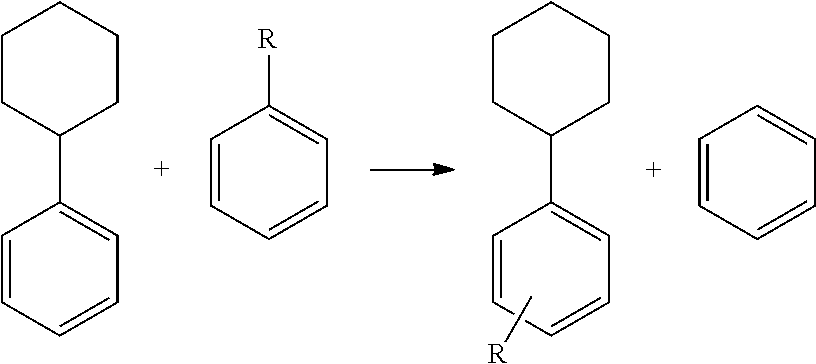Transalkylated cyclohexylbenzyl and biphenyl compounds
a technology of cyclohexylbenzyl and biphenyl, which is applied in the direction of hydrocarbon preparation catalysts, hydrocarbon by addition and hydrogenation, and organic chemistry. it can solve the problems of difficult control of the position of alkyl substitutions on each ring, and ineffective removal of unwanted substitutions. , the effect of increasing the selectivity of transalkylation products
- Summary
- Abstract
- Description
- Claims
- Application Information
AI Technical Summary
Benefits of technology
Problems solved by technology
Method used
Image
Examples
example 1
lbenzene Transalkylation with Various Alkyl Aromatics
[0102]The experiments discussed in Example 1 utilized a reactor unit with 8 parallel reactors heated by furnace. For different tests, anywhere from 1-8 reactors were utilized. The reactors consisted of quartz tubes of 9 mm inner diameter. Annular N2 flow on the outside of the quartz reactor allowed for pressure equilibrium between the inside and outside of each reactor channel. Catalyst extrudates (consisting of USY zeolite on alumina binder) were crushed to 20 / 40 mesh loaded in quantities of 2 g after being diluted up to 4 g in crushed quartz. A quartz wool plug was used at the top and bottom of the catalyst bed to keep catalyst in place. Two sets of 4 parallel reactors were placed in heated furnaces to control isothermal reaction temperature. Each reactor contained an internal thermocouple in the catalyst bed in a 1 / 16″ thermowell. The reactors were topped off with the same quartz chips.
[0103]The catalysts in all reactors were p...
example 2
yclohexylbenzene Transalkylation with Toluene
[0112]The transalkylation test of Example 2 was carried out in a fixed bed down-flow reactor. The reactor was ½ inch (1.27 cm) inner diameter. The catalyst used in the study was a commercial catalyst consisting of USY zeolite on alumina binder. The catalyst charge was 1.65 g, and the catalyst was activated by heating up the catalyst bed to 260° C., and then holding at that temperature for 8 hours. Hydrogen flow rate was 50 cc / minute. Reactor pressure was maintained constant, at 50 psig (344.7 kPag) throughout catalyst activation.
[0113]The feed used in the transalkylation test was prepared by physically blending anhydrous toluene purchased from Sigma Aldrich and cyclohexylbenzene purchased from Alfa Aesar in the ratio of 83:17 by weight. The transalkylation test was carried out at 180° C. Reactor pressure, WHSV, and hydrogen / hydrocarbon molar ratio were kept constant at 200 psig (1379.0 kPag), 2.5 hr−1, and 0.7, respectively.
[0114]Samples ...
example 3
Hydrogenation, Hydroalkylation, and Transalkylation
[0116]Biphenyl spiked experiments (e.g., feed comprising hydrogen, toluene, and biphenyl) were run in order to assess the feasibility to hydrogenate and transalkylate biphenyl type molecules directly inside a hydroalkylation reactor. Catalytic performance tests described in this example were carried out in a 7 mm diameter×150 mm isothermal reactor, equipped with a 1.6 mm internal thermowell for temperature monitoring.
[0117]Two different catalysts, both having 0.30 wt % Pd on a bound molecular sieve support comprising 80 wt % USY and 20 wt % Al2O3, were used: (1) catalysts with Si / Al2 ratio in the bound molecular sieve of 7, and (2) those with Si / Al2 ratio in the molecular sieve of 30. About 2 g of catalyst, sized to 0.4-0.6 mm particles, was diluted with amorphous silicon carbide and loaded into the reactor tube. Testing conditions were at a WHSV of 2 h−1 (on a total liquid feed basis) at 140° C. and 11 barg (1100 kPag).
[0118]The H2...
PUM
| Property | Measurement | Unit |
|---|---|---|
| temperature | aaaaa | aaaaa |
| temperature | aaaaa | aaaaa |
| temperature | aaaaa | aaaaa |
Abstract
Description
Claims
Application Information
 Login to View More
Login to View More - R&D
- Intellectual Property
- Life Sciences
- Materials
- Tech Scout
- Unparalleled Data Quality
- Higher Quality Content
- 60% Fewer Hallucinations
Browse by: Latest US Patents, China's latest patents, Technical Efficacy Thesaurus, Application Domain, Technology Topic, Popular Technical Reports.
© 2025 PatSnap. All rights reserved.Legal|Privacy policy|Modern Slavery Act Transparency Statement|Sitemap|About US| Contact US: help@patsnap.com



